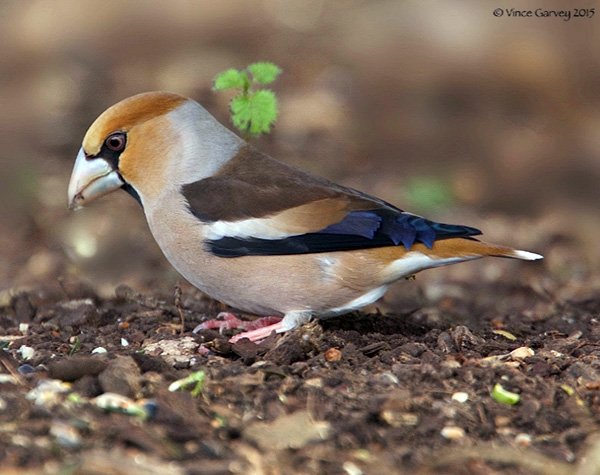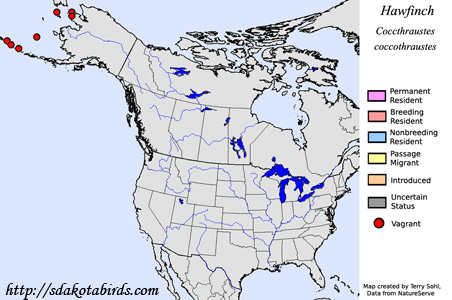| Length: 7 inches | Wingspan: 12.5 inches | Seasonality: Non-resident in South Dakota |
| ID Keys: Large powerful bill, black throat and eye stripe, buffy underparts, grey neck, orange-brown head and rump | ||
 The
Hawfinch is a widely distributed species in Eurasia, found in much of
Europe, far eastern Asia, parts of central and southwestern Asia, and far
northern Africa. In North America they are rare vagrants, with
Hawfinch occasionally found in the Aleutians, other islands off the west
coast of Alaska, or more rarely, on the western Alaskan mainland. The
Evening Grosbeak of North America is
a close relative, and the Hawfinch is sometimes referred to as the "European
Grosbeak". Their massive bill is used to crush hard seeds, with a bite force
strong enough for them to crush and consume cherry pits (one of their
favorite foods).
The
Hawfinch is a widely distributed species in Eurasia, found in much of
Europe, far eastern Asia, parts of central and southwestern Asia, and far
northern Africa. In North America they are rare vagrants, with
Hawfinch occasionally found in the Aleutians, other islands off the west
coast of Alaska, or more rarely, on the western Alaskan mainland. The
Evening Grosbeak of North America is
a close relative, and the Hawfinch is sometimes referred to as the "European
Grosbeak". Their massive bill is used to crush hard seeds, with a bite force
strong enough for them to crush and consume cherry pits (one of their
favorite foods).
Habitat: Mostly found in deciduous or mixed forest, but they are also found in parks, gardens, and suburban settings.
Diet: Feeds heavily on seeds, but will also take fresh buds, small fruits and berries, and insects and other small invertebrates. Insects are mostly consumed during the summer breeding season.
Behavior: Foraging behavior depends on food source. They will often forage directly on the ground, but will also forage in vegetation, all the way to the forest canopy. They are often shy and retiring.
Nesting: The nest of a Hawfinch is a poorly constructed saucer built of sticks, moss, and lichen, lined with animal hair, fine grasses, and rootlets. The female lays between 3 and 7 eggs, and she alone incubates them. Once the eggs hatch, both parents help to raise the young.
Song: A crisp single note is the most often heard vocalization.
Migration: Some populations are non-migratory, while some migrate for the winter. Birds found in Europe are mostly permanent residents, while many Asian populations are migratory.
Feeders: Hawfinch will sometimes attend feeders for offered fruits, peanuts, and sunflower seeds.
Interactive eBird map: Click here to access an interactive eBird map of Hawfinch sightings
Similar Species: For any bird that happens to be found in North America, most likely to be confused with Evening Grosbeak.
Conservation Status: Populations of Hawfinch are very large, considered stable, and are found across a very wide geographic region. The IUCN considers the Hawfinch as a species of "Least Concern".
Further Information: 1) Royal Society for the Protection of Birds - Hawfinch
2) British Garden Birds - Hawfinch
3) WhatBird - Hawfinch
Photo Information: Photo by Vince Garvey - Licensed under Creative Commons Attribution 2.0 Generic License.
| Click below for a higher-resolution map |
 |
| South Dakota Status: Non-resident in South Dakota |
Additional Hawfinch Photos (coming soon!!)
